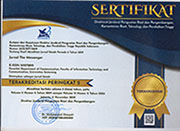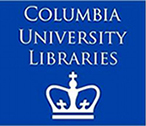Visualization on Twitter Activism Networks and Opinion Leaders: The Case of #FreeWestPapua
Abstract
Introduction: This study tries to visualize the Twitter activism networks and their opinion leader with the case of #FreeWestPapua activism. This study is important to find out who the opinion leaders and their networks are. This study also provides an overview of how the opinion leader frames opinions about #FreeWestPapua activism on Twitter.
Methods: This research used Social Media Network Analysis (SMNA). The SMNA method is the application of the Social Network Analysis (SNA) method to examine conversations on social media. Data collection and data processing are collected and visualised with Netlytic.
Findings: The results showed that there are 13 opinion leaders and all of the opinion leaders are from outside Papua. This study concluded that there is alienation in separatist activism in the case of #FreeWestPapua on Twitter. The most influential opinion leader in the separatist activism on Twitter is @VeronicaKoman who has the biggest values and is also active to frame public opinion. #FreeWestpapua activism framed Indonesia as a colonial in diagnostic framing and #FreeWestPapua as a solution in prognostic framing. To attract support from the international community, opinion leaders in #FreeWestPapua activism took advantage of the various #BlackLivesMatter issue and other international moments such as Korindo news by BBC.com.
Originality: Although a lot of research on the Free Papua Movement has been done, there has never been a study explains about who opinion leaders and their networks and also how they are framed public opinion about #FreeWestPapua activism on social media.Keywords
Full Text:
PDFReferences
Al-Rawi, A., & Groshek, J. (2018). Jihadist propaganda on social media: An examination of ISIS related content on twitter. International Journal of Cyber Warfare and Terrorism, 8(4), 1 15. https://doi.org/10.4018/IJCWT.2018100101
Anriani, S., Rahayu, A. Y. S., & Salomo, R. V. (2021). Indonesian collaborative governance analysis facing Free Papua movement. An ¡lisis Colaborativo de Gobernanza Indonesa Frente Al Movimiento de Pap ºa Libre, 26, 89 108. https://doi.org/https://www.redalyc.org/articulo.oa?id=27966514008
Ardiyanti, H., & Sudjono, I. R. (2020). The Impact of Communication on the Future of Reconciliation and Peacebuilding in Papua: Understanding the Meaning of Special Autonomy in Papuan Perceptions. Icri 2018, 1474 1481. https://doi.org/10.5220/0009930414741481
Ashrianto, P. D., & Yustitia, S. (2020). The Use of Social Media in Searching for Information about Papua. Jurnal The Messenger, 12(2), 122. https://doi.org/10.26623/themessenger.v12i2.1939
Bennett, W. L., & Segerberg, A. (2012). The logic of connective action: Digital media and the personalization of contentious politics. In The Logic of Connective Action: Digital Media and the Personalization of Contentious Politics (Issue September). https://doi.org/10.1017/CBO9781139198752
Bhakti, I. N., & Pigay, N. (2016). Menemukan Akar Masalah dan Solusi Atas Konflik Papua: Supenkah? (Finding the Root of Problems and Solutions to Papuan Conflict: Is it important?). Jurnal Penelitian Politik, 9(1). https://doi.org/http://ejournal.politik.lipi.go.id/index.php/jpp/article/view/443
Bruns, A., & Stieglitz, S. (2013). Towards more systematic Twitter analysis: Metrics for tweeting activities. International Journal of Social Research Methodology, 16(2), 91 108. https://doi.org/10.1080/13645579.2012.756095
Buente, W., & Robbin, A. (2008). Trends in internet information behaviour, 2000-2004. Journal of the American Society for Information Science and Technology, 11(59), 1743 1760. https://doi.org/https://doi.org/10.1002/asi.20883
Cammaerts, B. (2007). Media and communication strategies of glocalized activists: Beyond media-centric thinking. In Reclaiming the Media: Communication Rights and Democratic Media Roles. Intellect Books. https://doi.org/http://eprints.lse.ac.uk/id/eprint/3296
Chadwick, A. (2007). Digital Network Repertoires and Organizational Hybridity. Political Communication, 24(3), 283 301. https://doi.org/10.1080/10584600701471666
Elo, S., & Kyng ¤s, H. (2008). The qualitative content analysis process. Journal of Advanced Nursing, 62(1), 107 115. https://doi.org/10.1111/j.1365-2648.2007.04569.x
Eriyanto. (2021). Analisis Jaringan Media Sosial: Dasar-dasar dan Aplikasi Metode Jaringan Sosial untuk Membedah Percakapan di Media Sosial. Kencana (Prenadamedia Group).
Fruchterman, T. M. J., & Reingold, E. M. (1991). Graph Drawing by. Force-Directed Placement, in: Software-Practice and Experience, vol(March), 21no11pp1129-1164.
Gaisbauer, F., Pournaki, A., Banisch, S., & Olbrich, E. (2021). Ideological differences in engagement in public debate on Twitter. PLoS ONE, 16(3 March), 1 18. https://doi.org/10.1371/journal.pone.0249241
Gault-Williams, M. (1987). Organisasi Papua Merdeka: The Free Papua Movement Lives. Critical Asian Studies, 19(4), 32 43. https://doi.org/10.1080/14672715.1987.10409792
Gerbaudo, P. (2012). Tweets and The Street, Social Media and Contemporary Activism (First Edit). Pluto Press, Palgrave Macmillan.
Gerlitz, C., & Rieder, B. (2018). Tweets Are Not Created Equal: Investigating Twitter s Client Ecosystem. International Journal of Communication, 12, 528 547. https://doi.org/http://ijoc.org/index.php/ijoc/article/view/5974
Grant, P. R., & Smith, H. J. (2021). Activism in the time of COVID-19. Group Processes and Intergroup Relations, 24(2), 297 305. https://doi.org/10.1177/1368430220985208
Gruzd, A., Mai, P., & Kampen, A. (2017). A How-to for Using Netlytic to collect and Analyze Social Media Data: A Case Study of the Use of Twitter During the 2014 Euromaidan Revolution in Ukraine. The SAGE Handbook of Social Media Research Methods, 513 529. https://doi.org/10.4135/9781473983847.n30
Gruzd, A., Paulin, D., & Haythornthwaite, C. (2016). Analyzing Social Media And Learning Through Content And Social Network Analysis: A Faceted Methodological Approach. Journal of Learning Analytics, 3(3), 46 71. https://doi.org/10.18608/jla.2016.33.4
Haythornthwaite, C., & Gruzd, A. (2008). Analyzing Networked Learning Texts. Networked Learning Conference, Halkidiki, Greece, May 5 6, 2008, 136 143. https://doi.org/http://hdl.handle.net/2142/11518
Jolly, L. M. M. (1997). Introduction. In Sites of Desire/Economies of Pleasure: Sexual- ities in Asia and the Pacific (pp. 1 26). University of Chicago Press.
Kirsch, S. (2002). Rumour and other narratives of political violence in West Papua. Critique of Anthropology, 22(1), 53 79. https://doi.org/10.1177/0308275X020220010301
Kristianto, K., Ramadhan, A. B., & Marsetyo, F. D. (2021). Media Sosial dan Connective Action: Studi Kasus Penggunaan Twitter sebagai Ruang Solidaritas selama Pandemi COVID-19. Journal of Social Development Studies, 2(1), 1 13. https://doi.org/10.22146/jsds.1037
Kusuma, A. J., Setiawan, M. C. A., Ilmar, A., & Situmeang, N. (2021). Perubahan Status Organisasi Papua Merdeka ( Opm ) Menjadi Organisasi Teroris Oleh Pemerintah Indonesia : Sebuah Analisis Dalam Perspektif Ham. Jurnal of Government, 7(1), 131 155.
Lim, M. (2013). Many Clicks but Little Sticks: Social Media Activism in Indonesia. Journal of Contemporary Asia, 43(4), 636 657. https://doi.org/10.1080/00472336.2013.769386
Lindgren, S. (2013). The potential and limitations of twitter activism: Mapping the 2011 libyan uprising. TripleC, 11(1), 207 220. https://doi.org/10.31269/triplec.v11i1.475
Mackie, D. M., & Smith, E. R. (2018). Chapter One - Intergroup Emotions Theory: Production, Regulation, and Modification of Group-Based Emotions (J. M. B. T.-A. in E. S. P. Olson (ed.); Vol. 58, pp. 1 69). Academic Press. https://doi.org/https://doi.org/10.1016/bs.aesp.2018.03.001
Merdeka.com. (2021). DPR Setujui Anggota Pansus RUU Otonomi Khusus Papua | merdeka.com. https://www.merdeka.com/politik/dpr-setujui-anggota-pansus-ruu-otonomi-khusus-papua.html
Moy, P., & Bosch, B. J. (2013). Theories of public opinion, In Handbook of Communication Science. Vol. 1 : Theories and Models of Communication.
Nasution, M. A. R., & Wiranto, S. (2020). Propaganda Issues of Racism Through Social Media to Trigger Social Violence in Papua and West Papua in 2019. Jurnal Pertahanan: Media Informasi Ttg Kajian & Strategi Pertahanan Yang Mengedepankan Identity, Nasionalism & Integrity, 6(2), 212 224. https://doi.org/http://dx.doi.org/10.33172/jp.v6i2.857
Ngatiyem. (2007). Oorganisasi Papua Merdeka 1964-1998 (Studi Tentang Pembangunan Stabilitas Politik Di Indonesia) (Issue 235) [Universitas Sebelas Maret]. https://doi.org/http://digilib.unila.ac.id/4949/15/BAB II.pdf
Nufus, A. B., Mazid, S., Novitasari, Widiyanto, D., & Yasnanto. (2020). Papua s Vertical Conflict in 2019: Existence of Free Papua Movement and United Nations Response. 436, 1 5. https://doi.org/10.2991/assehr.k.200529.001
Nunes, R. H., Ferreira, J. B., de Freitas, A. S., & Ramos, F. L. (2018). Efeitos das recomenda µes de l deres de opini o em m dias sociais sobre a inten o de compra de seus seguidores. Revista Brasileira de Gestao de Negocios, 20(1), 57 73. https://doi.org/10.7819/rbgn.v20i1.3678
Nur afifah, O., & Prihantoro, E. (2021). The Influence of Social Media on Millennial Generation about Travel Decision-Making. Jurnal The Messenger, 13(3), 238. https://doi.org/10.26623/themessenger.v13i3.2328
Nurmandi, A., Almarez, D., Roengtam, S., Salahudin, Jovita, H. D., Kusuma Dewi, D. S., & Efendi, D. (2018). To what extent is social media used in city government policy making? Case studies in three asean cities. Public Policy and Administration, 17(4), 600 618. https://doi.org/10.13165/VPA-18-17-4-08
Otto Ondawame. (2000). One People, One Soul , West Papuan Nationalism and the Organisasi Papua Merdeka (OPM)/Free Papua Movement [The Australian National University]. https://doi.org/10.25911/5d77834624260
Republika.co.id. (2020). Lagu Tanah Papua Telah Terdaftar di Kemenkumham | Republika Online. https://doi.org/https://www.republika.co.id/berita/qjkpit366/lagu-tanah-papua-telah-terdaftar-di-kemenkumham
Robert D. Benford, & David A. Snow. (2000). FRAMING PROCESSES AND SOCIAL MOVEMENTS: An Overview and Assessment. Annual Review of Sociology, 26(1974), 611 639.
Rutherford, D. (2010). An Act of Free Choice: Decolonization and the Right to Self-Determination in West Papua by Pieter Drooglever. Indonesia. https://doi.org/https://doi.org/10.2307/20798238
Sampedro, V., & Avidad, M. M. (2018). The Digital Public Sphere: An Alternative and Counterhegemonic Space? The Case of Spain. International Journal of Communication, 12, 22. https://doi.org/https://ijoc.org/index.php/ijoc/article/view/6943/2214
Schradie, J. (2018). Moral Monday Is More Than a Hashtag: The Strong Ties of Social Movement Emergence in the Digital Era. Social Media and Society, 4(1). https://doi.org/10.1177/2056305117750719
Snow, D. A., & Byrd, S. C. (2007). Ideology, framing processes, and islamic terrorist movements. Mobilization, 12(2), 119 136. https://doi.org/10.17813/maiq.12.2.5717148712w21410
Snow, D. A., Rochford, E. B., Worden, S. K., & Benford, R. D. (1986). Frame Alignment Processes, Micromobilization, and Movement Participation. American Sociological Review, 51, 464.
Titifanue, J., Tarai, J., Kant, R., & Finau, G. (2016). From Social Networking to Activism: The Role of Social Media in the Free West Papua Campaign. Pacific Studies, 39(3), 255 281.
Tryasari, I. (2020). Konstruksi Media Online Dalam Pemberitaan Rasisme Etnis Papua Terkait Kematian George Floyd (Analisis Framing Pada Berita BBC.Com dan CNNindonesia.Com Edisi Juni 2020). Skripsi. Universitas Muhamadiyah Malang.
Webb-Gannon, C. (2022). 5 STARS ALIGNING West Papua in the Black Pacific and Beyond. In Morning Star Rising. University of Hawaii Press. https://doi.org/https://doi.org/10.1515/9780824888893-008
Xiong, F., & Liu, Y. (2014). Opinion formation on social media: an empirical approach. Chaos (Woodbury, N.Y.), 24(1), 013130. https://doi.org/10.1063/1.4866011
Xu, W. W., Sang, Y., Blasiola, S., & Park, H. W. (2014). Predicting Opinion Leaders in Twitter Activism Networks: The Case of the Wisconsin Recall Election. American Behavioral Scientist, 58(10), 1278 1293. https://doi.org/10.1177/0002764214527091
DOI: http://dx.doi.org/10.26623/themessenger.v14i1.4049
Refbacks
- There are currently no refbacks.
Copyright (c) 2022 Jurnal The Messenger
View My Stats [Jurnal The Messenger] is an International Scientific Journal, Published by the Department of Communication, Faculty of Information Technology and Communication, Universitas Semarang (Central Java, Indonesia). It is licensed under a Creative Commons Attribution 4.0 International License.



_11.jpg)




_BARCODE.jpg)
_BARCODE1.jpg)


5.png)










2.png)





